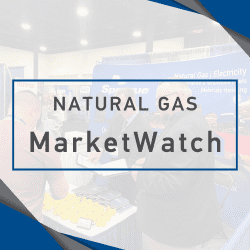Recap: Oil prices jumped on Wednesday, finishing the session at their highest level in a year, gaining support from the modest build in U.S. crude oil inventories and expectations that economic stimulus measures will increase demand for oil. Backwardation conditions, where the front end of the curve is more expensive than the back end, are currently at their steepest level in a year. This signals greater near-term demand and tighter supplies. Adding strength to the market were reports that OPEC and its allies were at 101% compliance to the origin production cut adjustments. Since April, OPEC+ has lowered output by a cumulative 2.1 billion barrels, according to sources close to the topic. March WTI settled at $56.06 a barrel, up $1.30, or 2.4%. Brent for April delivery added $1.32, or 2.3%, to settle at $58.78 a barrel. March RBOB added 2.3%, to settle at $1.6525 a gallon, while March heating oil rose 1.7%, to $1.7028 a gallon.
Technical Analysis: With the number of coronavirus vaccines increasing, it appears oil markets are gaining momentum to the upside. Meanwhile, OPEC+ and its compliance to production cuts is eating away at global supplies, further supporting prices. The main trend for this market is to the upside, with resistance set at $56.30 for WTI. We would like to see the March contract settle above this level and even better, $56.65. From there, we could see a push toward $60. There is a bit of resistance at $57.40. Support is set at $55 and below that at $53.55.
Fundamental News: According to the EIA’s 2021 Annual Energy Outlook, U.S. crude oil output will surpass the 2019 record of 1.25 million bpd in 2023. U.S. crude oil production is expected to increase to a peak of 13.88 million bpd in 2034. It expects U.S. energy consumption to largely return to 2019 levels by 2025.
The Joint Ministerial Monitoring Committee made no mention of changing its oil output policy at its meeting on Wednesday. A draft statement stated that the OPEC+ panel was “optimistic for a year of recovery in 2021.” It said oil stocks in OECD countries have declined for the fifth consecutive month in 2020. The oil cuts have so far removed 2.1 billion barrels from the market since April 2020. OPEC+ compliance with oil cuts in December was 101%. It reported that overproduction from OPEC members in December 2020 reached a cumulative 1.26 million bpd, unchanged from November, while non-OPEC cumulative overproduction in December increased to 1.42 million bpd from 1.2 million bpd in November. It said that while the gradual rollout of the vaccines around the world is a positive factor for the rest of the year supporting the global economy and oil demand, economic prospects and oil demand would remain uncertain in the coming months.
Russia’s Deputy Prime Minister, Alexander Novak, said Russia is aiming to be 100% compliant with its deal with OPEC and other leading oil producers to reduce output to support the global oil market. He also said it was important to watch the oil output of producers that are not members of the deal by OPEC and other producers, known as OPEC+.
Alaska’s Department of Revenue reported this week that North Slope production in January averaged 498,176 b/d in January, down from 514,887 produced a year ago and 525,075 produced in January 2019.
IIR Energy reported that U.S. oil refiners are expected to shut in 3.7 million bpd of capacity in the week ending February 5th, cutting available refining capacity by 53,000 bpd from the previous week. Offline capacity is expected to fall to 3.5 million bpd in the week ending February 12th.
Early Market Call – as of 8:15 AM EDT
WTI – Mar $56.06, up 37 cents
RBOB – Mar $1.6530, up 44 points
HO – Mar $1.6958, up 51 points
View the Sprague Refined Products Market Watch Report in a downloadable pdf format by clicking below.
Click to view more online:
Heating Oil Supplier
Diesel Supplier
View market updates
View our refined products glossary
Go to SpraguePORT online










